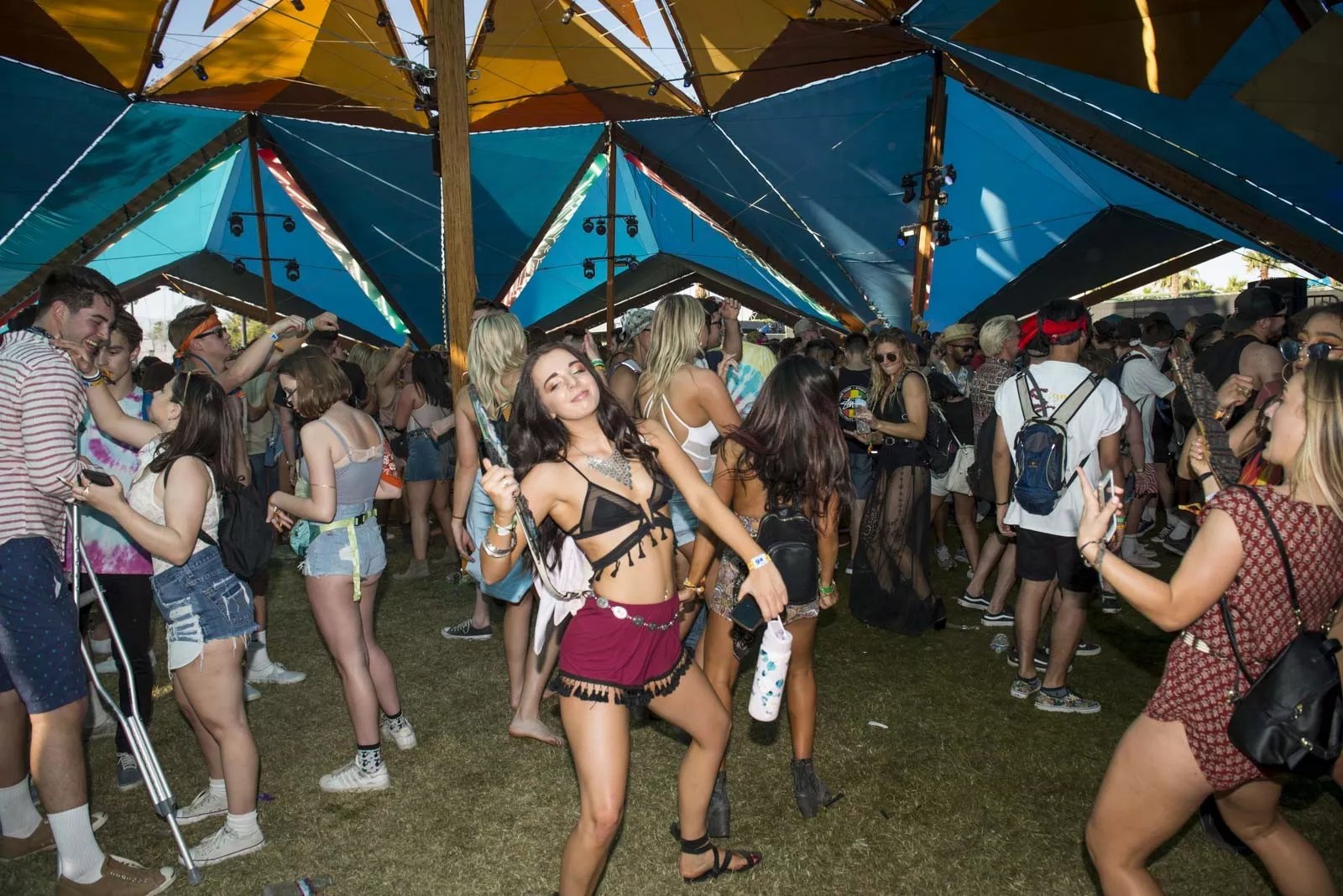
Shane Lopes

Audio By Carbonatix
Walk through the section of Coachella called the Terrace, past the Beer Barn and a series of towering white lamps out of some giant’s IKEA catalog, and you’ll see a graceful spire rising in the distance, covered in interlocking panels like the scales of a fishtail. Walk closer and the structure reveals itself to be even larger and prettier than it first appears, a sprawling, origami-like tent that houses one of Coachella’s most popular attractions, the DoLaB Stage.
The activity going down inside the tent is less graceful than the architecture that contains it. Two girls twerk aggressively under a set of misters that curtain one of its edges. From the stage, someone on a microphone yells, “Make some fucking noise!” A packed, sweaty crowd responds with a cheer, then bounces in unison as a DJ called Partywave dowses them in wave after wave of pummeling bass. Coachella is barely two hours old, but this place is already going off.
At the moment, the three men most responsible for this party are nowhere to be found. Brothers and DoLaB co-founders Josh, Jesse and Dede Flemming were part of the crew that worked through the night completing construction of their massive stage structure called “The Beacon” – co-designed by Josh and Heather Shaw – and getting all the sound, lights and gear up and running before the festival opened its gates. So now they’re getting some much-needed rest.
“We’re very hands-on,” Josh says in an interview the week before. He and his brothers are speaking via Google Hangout, sitting on an empty expanse of grass that, in just a few days, will become Coachella’s Terrace. “We don’t just draw pictures and then send a crew out to build it. We’re out here cutting lumber. It’s pretty labor-intensive, but we prefer to be out here in the grass.”
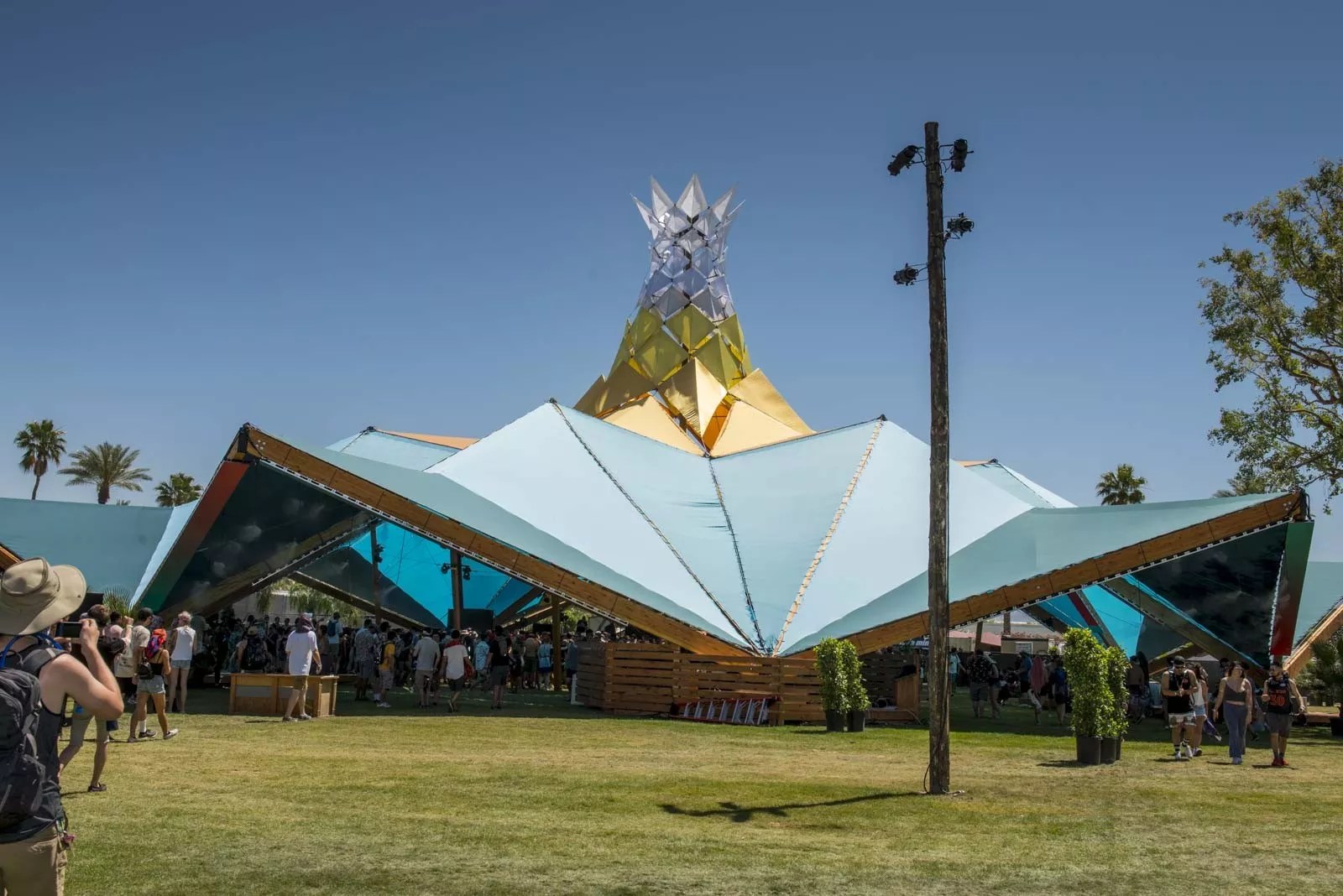
The Beacon, DoLaB’s 2017 stage structure
Shane Lopes
Every year since 2004, the DoLaB has occupied a unique place within Coachella’s elaborate and ever-growing ecosystem. What began as a combination art installation and chillout area has grown into a sort of festival within the festival – a temporary autonomous zone where the Flemming brothers and their crew are given free rein to design whatever they want, book whomever they want, even have their own backstage area where friends and associates can grab a beer and a veggie burger and escape the masses.
“They like the work that we’re doing and just allow us to create whatever we want,” says Josh. He wears a black DoLaB baseball cap and sits between his brothers. An occasional golf cart trundles past behind them. “And kinda do whatever we want, as long as we don’t break…”
“Yeah, too many rules,” Jesse chimes in, finishing his twin brother’s sentence.
In 2004, Coachella was smaller and more Wild West, a two-day festival on a single weekend with art curated by Philip Blaine, a former rave promoter best known for throwing a 1996 festival in Big Bear called Organic headlined by the Chemical Brothers, Underworld and Orbital. Blaine pulled most of the festival’s art installations from the Burning Man scene, which the Flemming brothers had gotten involved in after moving to L.A. from their home state of Pennsylvania in the early 2000s. Through their friend Paul Clemente, who is now Coachella’s art director, the brothers got a chance to pitch their first large-scale Coachella installation, a 60-foot dome that was fairly primitive compared to the soaring structures for which they’re now known.
When they never got a response to their proposal, they assumed the project had been rejected. Then, just a week before the festival, they were asked to come out and build their dome. The brothers and their crew scrambled, but got it completed just before the doors opened. “We ended up having to pull an all-nighter,” remembers Jesse, who is the trio’s production manager, “which actually became a tradition for about a decade.”
In those early days, “we were definitely renegade,” says Josh. Their original proposal hadn’t said anything about sound, but they smuggled a small system in anyway and turned the dome into a party space for their friends and curious attendees. “After the show, Goldenvoice recognized it was actually nice to have a smaller stage, not sanctioned but just playing music inside the festival.” So they were invited back.
“They gave us an inch and we kinda ran with it,” says Dede, who manages the DoLaB’s logistics and business affairs. “We just booked out the whole weekend with performances and DJs. And it snowballed from there.” By its third year, the DoLaB “misting oasis,” as it was known at the time, was becoming known as the place to go to hear the glitchy, bass-heavy sounds of underground dance music and get a glimpse of Burning Man’s theatrical, rave-meets-steampunk culture through performers like the Lucent Dossier Experience, a sort of post-apocalyptic Cirque du Soleil. (Full disclosure: I performed on the DoLaB stage in 2005 as part of a band/performance-art troupe called The Mutaytor.)
Even once their sound became sanctioned, the DoLaB’s renegade spirit remained. “In the early years, we were notorious for, at midnight or 1 a.m., when all the sound was supposed to shut off, we just kept going,” Josh says. “We would literally hide the generator and force production to come over and pull the plug.”
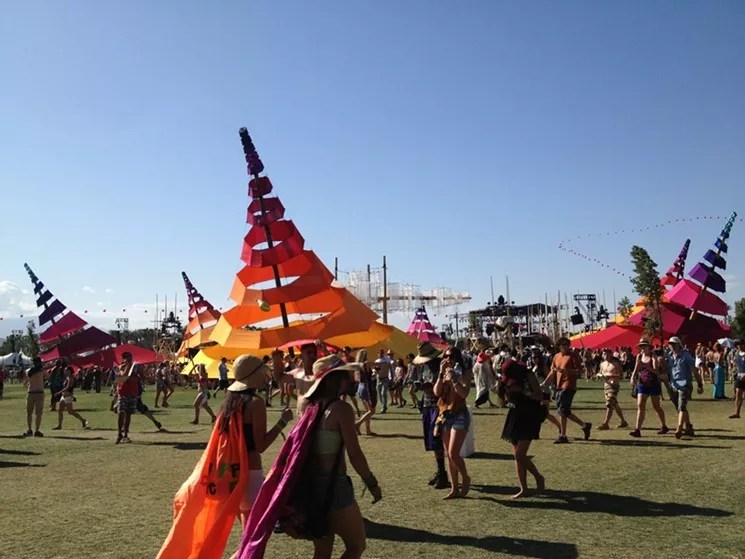
The DoLaB circa 2013, when it was still in the middle of the festival
Mary Grace Cerni
For many years, the DoLaB occupied a prime piece of Coachella real estate, in the middle of the field midway between the Coachella Stage and the Outdoor Theatre, the festival’s two biggest spaces. Attendees on their way from Blonde Redhead to the Red Hot Chili Peppers could wander through and stumble upon the otherworldly sounds of then-underground DJs like Bassnectar and The Glitch Mob.
But the location could be problematic, too. “It was really becoming a nuisance for a lot of people,” says Jesse. “You wanted to see Devendra Banhart on the Outdoor Theatre in the afternoon and we’d be cranking this bass music all day long – people were kinda getting pissed off at us.”
Often, Coachella would force the DoLaB to shut down during quieter performers like Leonard Cohen, and as word got out about the little stage with the big sound system, even more raucous headliners, like Dr. Dre, would mandate that they not compete. “So we’d have to go dark at the peak time, and it was frustrating for us,” says Dede.
Still, when the festival relocated the DoLaB in 2014 to its current home at the southernmost edge of the Terrace, a long trek from every stage except the EDM-centric Sahara Tent and the enclosed, club-like Yuma Tent, “it was a big disruption,” Dede says. “We had spent 10 years in the middle of the field, and to come to the corner was something totally different. And for festival-goers, they didn’t even know this real estate existed, because it hadn’t before.”
As a joke, someone printed up T-shirts reading, “No one puts DoLaB in the corner.” But after a year of what the brothers call “growing pains,” they came to embrace their more secluded location, where they could beef up their sound system without fear of bleeding onto other stages, and expand their backstage area into their own private party pad. “We love it back there now,” says Dede.
The new location is also conducive to building larger, more elaborate structures like those seen at the DoLaB’s own events, particularly their flagship festival, Lightning in a Bottle. In 2015, they debuted a majestic, elongated vault of wood and colorful fabric shaped like a whale skeleton and nicknamed the “Big Fish.” The new structure was so popular that, for the first time, the brothers decided to bring it back for a second year. This year, they replaced it with the towering, pagoda-like structure called The Beacon; if it’s as well-received as Big Fish, it, too, will make a return appearance. (“We were getting really tired,” Jesse admits. “It’s hard to keep pushing the boundaries and one-upping ourselves every year.”)
Of course, no matter how cool their structures are, DoLaB wouldn’t be a success without great DJs and performers putting their crispy, punchy Meyer Sound system through its paces. The Flemmings book the stage themselves and have become masters at mixing up-and-coming underground talent with bigger names and surprise headliners. This year’s confirmed artists include The Gaslamp Killer, Mr. Carmack and Justin Martin. The Friday night surprise guest was Chicago future bass duo Louis the Child; past guests, often booked at the last minute, have included the likes of Bonobo and Chet Faker.
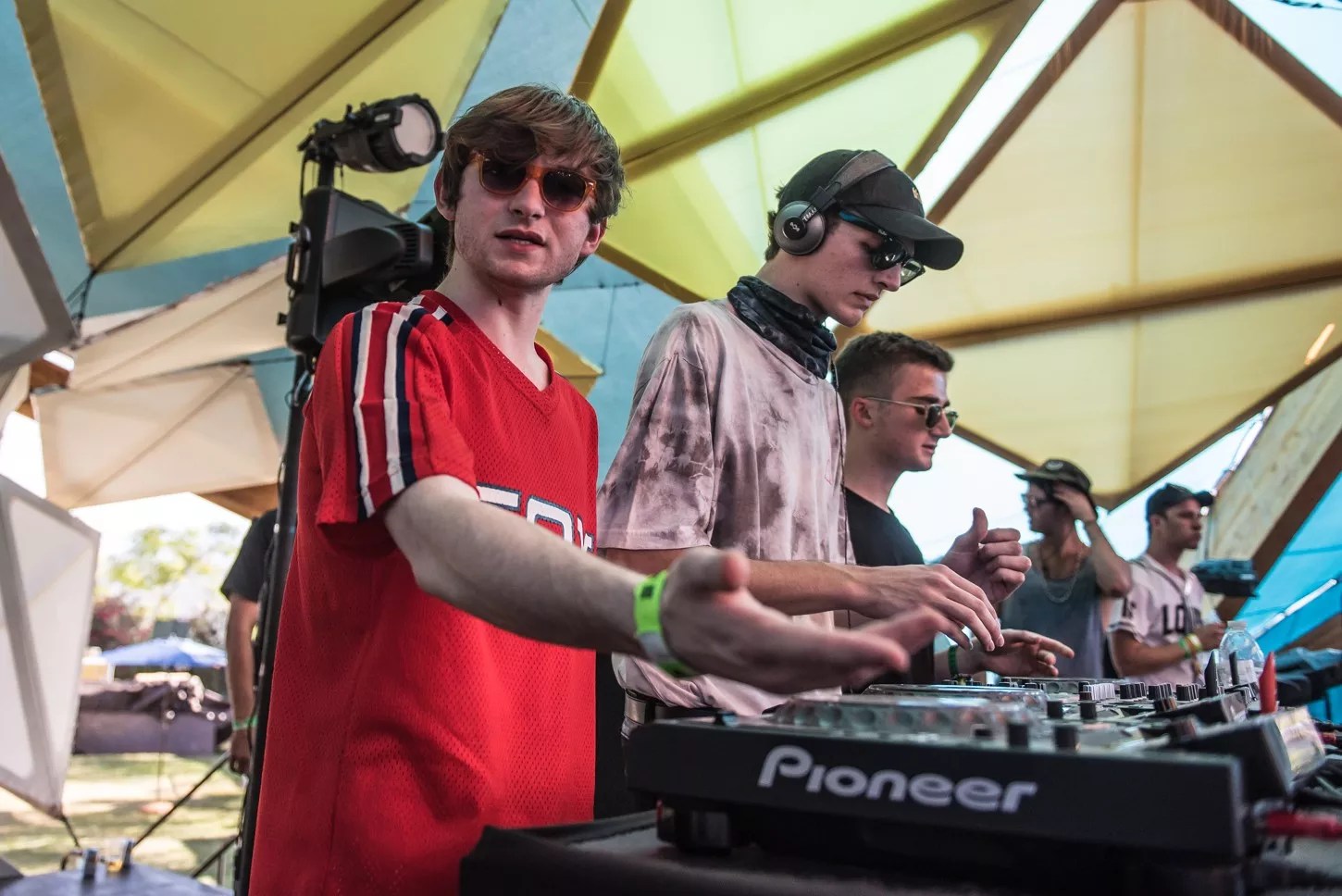
Louis the Child at the DoLaB stage during the Brownies and Lemonade “takeover.”
Mathew Tucciarone
Unlike Coachella’s “official” stages, the DoLaB has different lineups on the festival’s two weekends, a quirk of the fact that, because production costs eat up most of the modest budget, DoLaB Stage performers aren’t paid. “We kinda search around and we find artists that are already here,” Jesse explains. “A lot of artists come out here just to hang out because it’s such a big festival.”
At this point, the brothers have come to enjoy booking different lineups on each weekend: “It gives us a chance to branch out and bring more artists in.” And because the artists aren’t doing it for the money, it keeps the vibe informal and gives them a chance to book more underground talent. This year, that includes a two-hour “takeover” party by L.A. promoters Brownies and Lemonade the first weekend, and appearances by the Desert Hearts DJ crew on weekend two.
One of the great pleasures the Flemming brothers get out of hosting their own stage at Coachella is watching the EDM kids wander in from the Sahara Tent and, often, leave as converts to the DoLaB’s more playful, less fist-pumping approach to throwing a good dance party. “A lot of people come to Coachella that only know Coachella. They don’t know what else is out there,” says Dede. “There’s a different energy inside of our dance floor, where people can be themselves and be free. There’s no judgment. And that really inspires people.”
“What we do is not for everybody,” adds Josh. “But the space we create here speaks to certain people. They really connect to it. And those are the people we see kind of make their way over to Lightning in a Bottle, ’cause they want to explore more of that.”
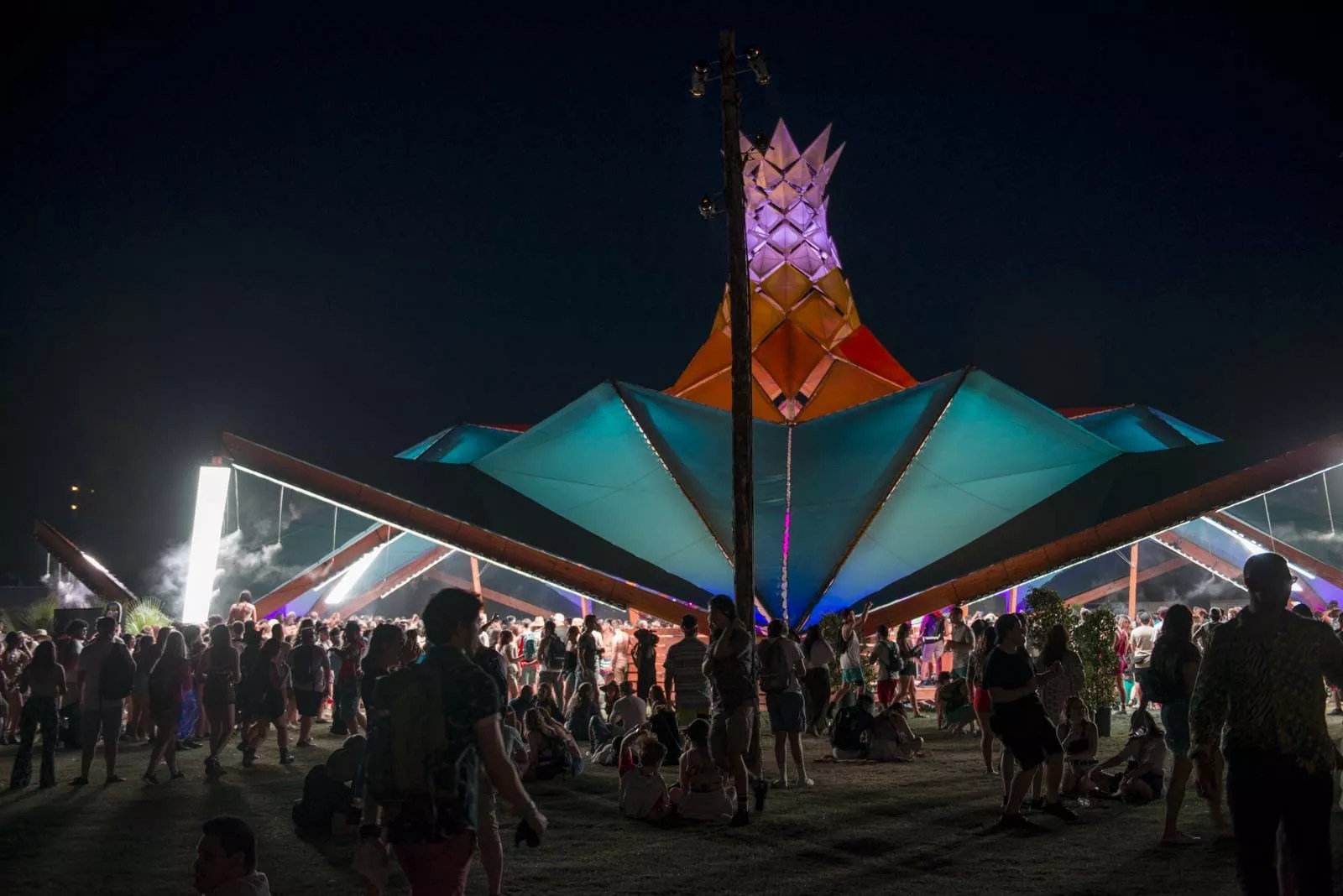
The Beacon at night.
Shane Lopes
Ultimately, the Flemming brothers hope that, through their little corner of Coachella, they can open people’s minds to the idea that a good festival can be about more than just dancing, partying and listening to music. “We’re big fans of concerts and shows,” says Jesse, “but we really like to break it down.” They like to make their spaces inspire awe and wonder, but also feel intimate – the kind of environment where you can share a laugh with a stranger or get misted by a performer. Though the DoLaB Stage at Coachella offers only a sliver of that kind of experience compared to Lightning in a Bottle, it’s a gateway into the DoLaB world – one that, every year, more and more people are venturing into.
“We’d love to take over this terrace and add more of the crazy stuff we have at LIB,” Jesse says, gesturing around at the expanse of grass behind him and his brothers, “but I don’t think Coachella would ever have it. It doesn’t quite fit their vibe here.”